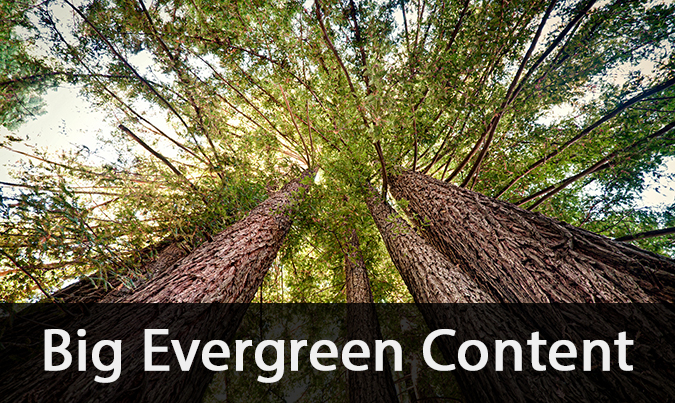Craig Charley
22 Apr 2013
Big Wins that Last - Why Big Evergreen Content is the Best Content Strategy
In 2013, most businesses realise the importance of content. That's why so many SEO agencies are repositioning themselves as content agencies, or at least offering it as a primary product. Our Content Marketing courses used to attract mainly bloggers, but since the Panda and Penguin Google updates we have seen a large increase in SEOs wanting to learn about content.
Yet this mass conversion to content brings up some issues - there is too much noise. Most businesses are still stuck in an outdated content strategy - regular, mediocre quality blog posts with little intent. The content is happening, but is it working?
With content at the forefront of so many marketing strategies, it seems at first glance that big businesses have a massive advantage. Whole in-house marketing teams as well as high profile agencies on hand to craft incredible content. How does a small business compete against this with a 1-3 person marketing team?
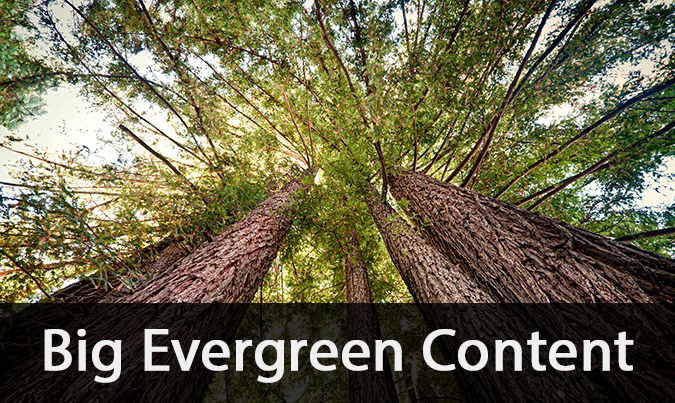
Big Evergreen Content
The idea for this post was sparked by Hannah Smith's talk at BrightonSEO 'Go Big or Go Home'(excellent write up on State of Search), which prompted me to revisit Dr. Pete's SEOmoz post at the end of last year 'Why Big Content Is Worth the Risk'. Both Hannah and Dr. Pete explain why big content is necessary and how it can help your business stand out in a very crowded world of below par blog posts:
"We all want the low-hanging fruit, but let’s be honest – the low-hanging fruit is rotten, bruised, and covered with the grubby fingerprints of all the other spoiled brats pawing at it."
The consensus of both the talk and the post is that big content takes around 40 hours to produce. Hannah compared this to an average 12 hours for 'small content' but I think that's a huge overestimation for the majority of businesses. James Carson recently alerted Twitter to the existence of a job ad for an agency looking for a Marketing Executive who for £18,000 a year had to write 25 blog posts a day. That's well over 6,000 articles a year on a range of topics, written by somebody with little knowledge about the subject and obviously no research.
With that much noise, it's important to be different to break through, and that's where big content comes in. But I'm going to go a step further and ask you to consider another element - sustainability. Another popular topic at BrightonSEO, and a common phrase in marketing blogs at the moment is Evergreen Content.
In the rest of this post I'm going to try and convince you why your content should be both big and evergreen for the holy grail of content marketing.
Of course, creating content is one thing but you need to make sure it's discoverable and that people know about it. If you're a seasoned writer but aren't up with your marketing, why not consider our SEO training and Social Media courses? They'll help you get your content in front of the right people.
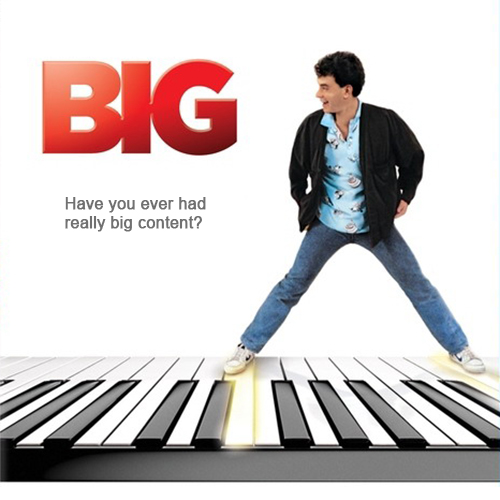
Why Go Big?
Big content is all about ROI; something Hannah was keen to emphasise at BrightonSEO.
Spending more time on fewer pieces of content should produce a higher ROI, not just in numbers of visits/links but also in their quality.
Hannah used 40 hours as the average time to produce big content, while an okayish blog post would take around 4 hours from concept to execution. Now that's a very hard sell to managers/ clients/ stakeholders: "I want to produce one thing in the time it would normally take me to produce ten." But the benefits pay off.
Here is a completely made up example to illustrate this:
- Business A creates 10 mediocre blog posts. Each post receives 500 hits and 2 links, totalling up to 5,000 hits and 20 linking root domains, most from low level bloggers in their niche.
- Business B creates 1 outstanding resource. It attracts attention from some of the biggest curators in the niche, leading to 50,000 hits and 40 linking root domains, including some from the biggest players in the industry.
- Business B's strategy results in 10 times the traffic and twice the links of Business A's, for the same investment.
While that example is purely theoretical, we believe (along with many of the speakers at BrightonSEO) that it's illustrative of what happens. Here's one of Hannah's slides showing linking root domain numbers for big content:
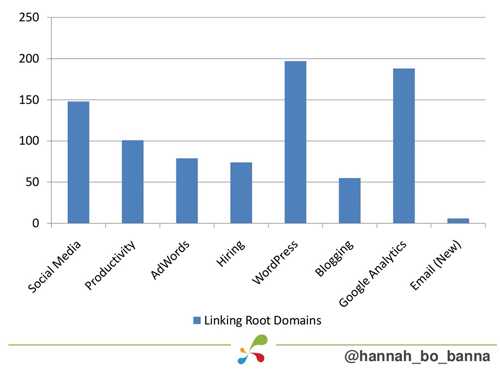
Going back to my example, Business A would need to attract 20 linking root domains per blog post to have the same return as the WordPress for Small Business guide as shown in the chart. That not very likely for your average business.
Why Go Evergreen?
Evergreen content sticks around. That traffic spike around the day you publish it doesn't dwindle off into nothing, it's there for the long haul.
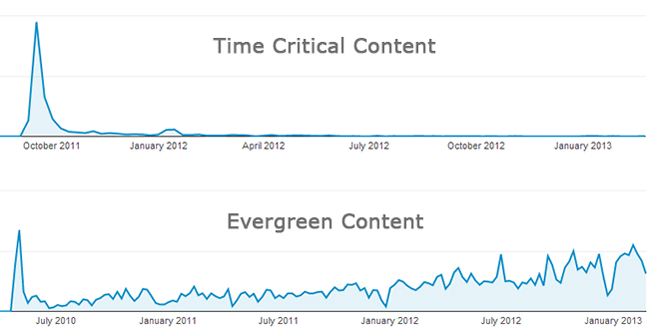
There's nothing wrong with current content - a well-timed release can do wonders for your traffic (and links) when you are the first to report news, or present a unique take on an event.
However, if that's your only strategy then you need to be publishing content at a journalist's pace - something that few businesses can manage. Plus those links start to fade as the topic reaches its sell by date.
If you're looking to content to increase your traffic over time (which you should be) then it's a lot easier if each piece of content retains a steady level of traffic. With evergreen content, each new piece adds to your previous traffic. With time critical content you are always working to replace the traffic from the last piece and any increase takes a lot longer, relying on loyal return visitors to build up your steady traffic.
It's Time to Think Big
Back to Dr. Pete for this one - "Big content needs big concepts, but it doesn't have to be lengthy." If the concept isn't big enough then the content won't work.
Using Dr. Pete's example, he spent 30-40 hours creating a 1-page PDF (which combined years of client experience). The results were astounding, and the piece still receives tonnes of traffic (evergreen!)
Most marketers could knock together a 1-page PDF in a couple of hours, but without that investment in the idea and planning it would never reach an audience like this:

(PS. These figures are from 2012 - THREE YEARS after publication!)
As a marketer or business, it is time to sit down and think big. If you want to compete in a crowded space, stop asking 'what should I write about today?' and start answering some of these questions:
- Who am I targeting with my content? Establish a set of personas for your website. Why would each persona want to visit? What are their goals?
- How can I help my customers? Disseminating information isn't enough, explain why that information matters and how it can help your visitors.
- Is my content any different to my competitors? If your aim is to capture a bigger chunk of your market, what are you doing to stand out from your competitors? Are you all just writing 500 word blog posts every few days? If so, what makes yours better? Don't use competitor research to copy your competitors, use it to beat them.
When executed properly, big content can turn your business into a thought leader. Here are some of the examples from Hannah's talk (also mentioned in Dr. Pete's post!) of Simply Business's big content:
- The Productivity Series
- Google AdWords: The Small Business Guide
- The WordPress Guide for Small Businesses
- The Small Business Guide to Google Analytics
Not only does each piece of content appeal directly to Simply Business's target market (small businesses) but it does it in a way that smashes traditional concepts of online content. You can see the time and effort that went in to creating the guides, and it paid off.
So if you're struggling with your content, or still creating content just for SEO, step back and rethink your strategy. Have a look at your analytics - are you getting any return for your content or are you doing it just because everyone else is? Start thinking big and start thinking evergreen and you will be surprised what can happen.
